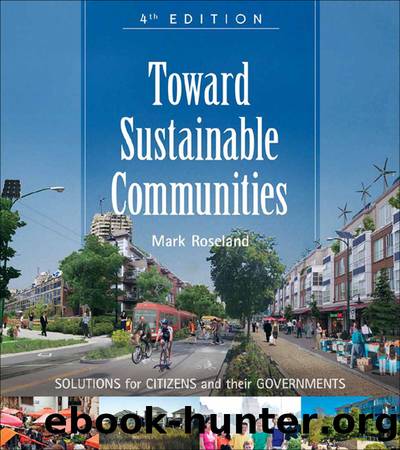Toward Sustainable Communities by Mark Roseland

Author:Mark Roseland
Language: eng
Format: epub
ISBN: 9781550925067
Publisher: New Society Publishers
Affordable Housing Ordinance: The City of Chicagoâs Affordable Requirement Ordinance was first passed in 2003 and updated in 2007 to require developers to create affordable units. Any development of ten or more units where the developers purchased land from the city or required a zoning change are required to have 10 percent affordable units, while those receiving financial assistance supplied by the city are required to have 20 percent affordable units. Developers may also choose to pay an in lieu fee of approximately $100, 000 per unit, based on the Consumer Price Index, to the cityâs Affordable Housing Opportunity Fund (Centre for Housing Policy 2010).
Creating Community
To create a âsense of placeâ and foster connection among people, the physical placement of buildings must draw people together and encourage an atmosphere of peace, security and pride among residents of a community. In addition to thoughtful building design, clean streets, gardens and trees, places to gather can create a village-like atmosphere even in innercity neighborhoods. Ideally, closeness to other people is mirrored in closeness to nature and integration of ecology into community living.
However, the physical design of housing and neighborhoods alone cannot create communities. Government policies and the actions and initiatives of local citizens are critical. Churches have often been the center of community, but in more recent times, people have also sought connection through involvement in neighborhood groups and activities, and participation in other non-government organizations such as environmental groups.
While responsible participation in governance is important, getting to know your neighbors is a simple first step. Getting involved and creating opportunities for inclusiveness are even bigger steps. True and rich community is a mix of people of many ages, socioeconomic backgrounds, ethnicity and abilities sharing their lives.
Looking Beyond Housing to Community Development
By John Emmeus Davis
Housing has long been a bellwether of neighborhood well-being or, conversely, of neighborhood decline. Many public and private interventions aimed at stabilizing or revitalizing residential neighborhoods have been focused primarily (sometimes exclusively) on improving the local housing stock. This once meant bulldozing entire blocks of âblightedâ buildings and replacing them with newly constructed publicly subsidized rentals. Subsequent interventions were aimed at rehabilitating a built environment that already provided affordable housing, or deconcentrating poverty by making it easier for low-income people to âmove to opportunityâ outside of inner-city neighborhoods or promoting a wider range of incomes by increasing the incidence of owner-occupied housing in neighborhoods dominated by rental housing. The supposition, in every case, was that âgood housing,â whether defined in terms of condition, affordability or tenure, was sufficient for a âgood neighborhood.â Secure the one, you secured the other.
The centrality of housing has been challenged in more recent years by a new generation of city planners, non-profit developers and community organizers who have advanced a more comprehensive vision of community development. Without denying that housing can play a large role in determining a neighborhoodâs fate, they point out that jobs, schools, parks, gardens, stores, safety and services do so as well. Good housing is not enough.
Such criticism has
Download
This site does not store any files on its server. We only index and link to content provided by other sites. Please contact the content providers to delete copyright contents if any and email us, we'll remove relevant links or contents immediately.
| Advertising | Consumer Behavior |
| Customer Service | Marketing |
| Public Relations | Sales & Selling |
| Search Engine Optimization |
Influence: The Psychology of Persuasion by Robert B. Cialdini(4716)
The Miracle Morning by Hal Elrod(4640)
The Hacking of the American Mind by Robert H. Lustig(4319)
Pre-Suasion: A Revolutionary Way to Influence and Persuade by Robert Cialdini(4153)
Unlabel: Selling You Without Selling Out by Marc Ecko(3591)
Ogilvy on Advertising by David Ogilvy(3517)
Hidden Persuasion: 33 psychological influence techniques in advertising by Marc Andrews & Matthijs van Leeuwen & Rick van Baaren(3476)
Purple Cow by Seth Godin(3143)
Who Can You Trust? by Rachel Botsman(3089)
Kick Ass in College: Highest Rated "How to Study in College" Book | 77 Ninja Study Skills Tips and Career Strategies | Motivational for College Students: A Guerrilla Guide to College Success by Fox Gunnar(3077)
The Marketing Plan Handbook: Develop Big-Picture Marketing Plans for Pennies on the Dollar by Robert W. Bly(2978)
This Is Marketing by Seth Godin(2974)
I Live in the Future & Here's How It Works by Nick Bilton(2938)
The Power of Broke by Daymond John(2900)
Building a StoryBrand by Donald Miller(2843)
The Tipping Point by Malcolm Gladwell(2829)
The 46 Rules of Genius: An Innovator's Guide to Creativity (Voices That Matter) by Marty Neumeier(2799)
Draw to Win: A Crash Course on How to Lead, Sell, and Innovate With Your Visual Mind by Dan Roam(2740)
Market Wizards by Jack D. Schwager(2645)
